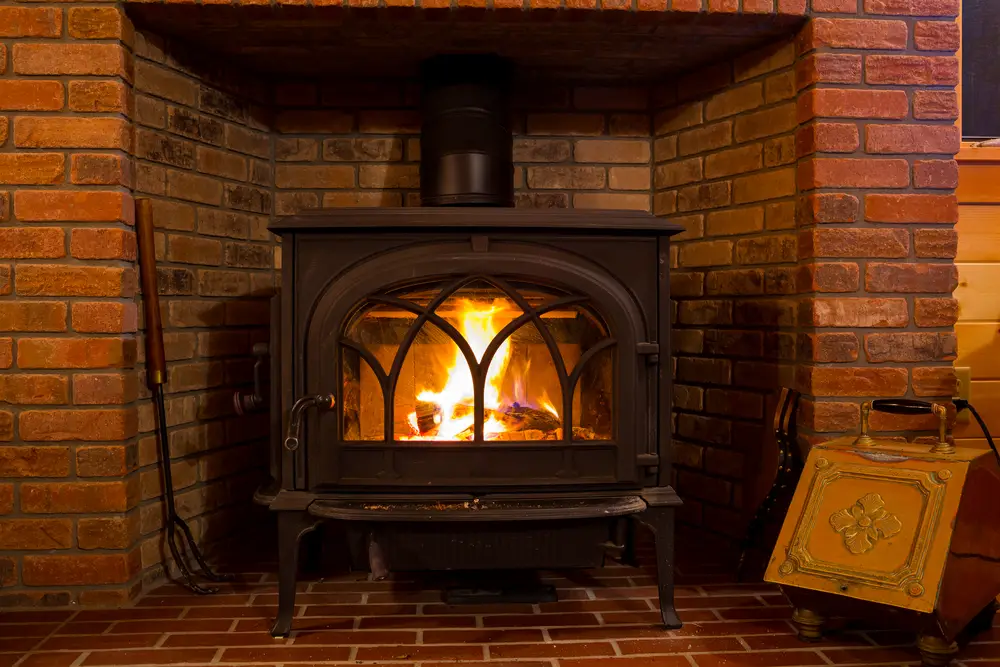Wood-burning stoves, favored for their excellent radiant heat and efficiency, raise concerns about potentially emitting carbon monoxide, a colorless and odorless but hazardous gas, prompting questions about its actual impact.
All non-electric heating solutions, including wood-burning stoves, emit carbon monoxide. There is a risk of carbon monoxide poisoning if this gas accumulates inside your home. The good news is, you can prevent this danger by keeping the chimney functional and installing a carbon monoxide alarm.
Read on to find out more about the hazards of CO poisoning associated with wood-burning stoves and uncover crucial tips and information to ensure safe usage.

Does a wood-burning stove emit carbon monoxide?
Yes, carbon monoxide is one of the gasses produced when wood is burned. A wood-burning stove also emits carbon dioxide, sulphur, dioxide, and nitrogen dioxides.
With that said, as long as a wood-burning stove has a sound chimney, and the fire has proper ventilation, CO poisoning is not a risk. A properly functional wood stove does not emit dangerous quantities of carbon monoxide.
How does a wood-burning stove emit carbon monoxide?
No matter what fuel you burn, the process of combustion produces carbon monoxide. When any hydrocarbon-based fuel is completely burned, the combustion yields carbon dioxide and other gasses, but very little, if no, carbon monoxide.
A wood burner produces carbon monoxide only when the ideal ratio of fuel to air is not ideal. A gas leak also occurs due to the poor installation of a stove. One major problem with carbon monoxide is that it is invisible, odorless and tasteless. So, without the help of a carbon monoxide detector, you may not be able to detect a high level of carbon monoxide in the air.
Newever models of range cookers, however, are remarkably more sophisticated than traditional conventional wood-burning stoves. Rayburn ranges provide more safety in terms of CO poisoning.
What factors influence CO production in a wood-burning stove?
A properly functional wood-burning stove with no technical issue does not release dangerous levels of carbon monoxide. Here are some circumstances under which the risks of exposure to CO increases dramatically:
- A poorly installed stove: The installation of a wood stove must comply with the local regulations. Consider hiring a professional to get your stove installed rather than taking it as a DIY project.
- A clogged or blocked flue: If you burn wet wood or bituminous coal, the chimney flue will get clogged pretty quickly. Slumbering for long periods can also result in clogging. It usually happens when the chimney is not cleaned regularly.
- Lack of ventilation in the room: This is one of the major causes of carbon monoxide poisoning. For stove installations, there are strict requirements for ventilation in most places in the UK and the USA.
- The stove is used in a room with an extractor fan: By pulling air out, an extractor fan reduces the efficiency of the flue draught and weakens the stove’s fire. And it increases the danger of CO poisoning. That’s why UK Building Regulations do not allow the installations of a solid fuel-burning stove and an extractor fan in the same room.
- Burning wet wood: The combustion of wet wood is associated with the emissions of high amounts of carbon monoxide. This is because wet wood burns less efficiently, produces less heat, and releases more smoke.
How to reduce carbon monoxide emission from a wood-burning stove
Carbon monoxide poisoning is a real risk, and taking steps to reduce the emission of this gas is of utmost importance. Here are a few things you can do to reduce, even eliminate this risk:
Install a carbon monoxide detector. When carbon monoxide levels start rising in your home, this device gives an alarm that can save your life. However, there is still the risk of exposure to other harmful gasses. To avert the risk altogether, you have to install a heat pump, which is remarkably safer than any combustion-based unit.
Hire a professional installer to get your stove installed. Installing a wood-burning stove is not rocket science, but there are subtle technical nuances that you may not know. The service of a professional, you will have some peace of mind.
Burning wet wood can increase the risk of carbon monoxide poisoning, so be sure to use properly seasoned wood only. Also, never burn wood that is covered in paint, even if the wood is perfectly dry.
And for the safe and efficient operation of the stove, make sure there is sufficient ventilation in the room. Even if there is a leak, proper ventilation will prevent the build up of carbon monoxide.
Also, clean your wood stove and its chimney regularly. A clogged flue can induce CO poisoning, so make sure there is no obstruction in the flue.

Do you need a carbon monoxide alarm with a wood-burning stove?
Carbon monoxide, often referred to as a “silent killer” kills about 30 people every year in the UK alone. In the UK, installing carbon monoxide alarms is a legal requirement for homes with solid fuel burning appliances.
This device can save your life in case of a CO leak. If the alarm goes off, the first thing you have to do is to open the doors and windows. They immediately leave the building and call emergency services.
Do not use a carbon monoxide device for more than 5 years. After that point, a device becomes less reliable. Read the user manual of your CO detector to learn about the recommended replacement age of the device.
Where to place a carbon monoxide alarm with a wood-burning stove
Ideally, the CO detector should be installed 1 to 3 metres from your wood-burning stove, in a horizontal position. The height should be at around eye level. Do not place the device too close to the stove, because that will affect the functionality of the device.
Install it in a convenient place so that you can hear the alarm whenever it goes off. It should not be far from your bedroom, because in such a case you may not be able to hear the alarm before it is too late.
Many people tend to confuse smoke detectors with carbon monoxide detectors. As the name suggests, a smoke detector detects smoke, which is the early sign of a fire.
You can place a carbon monoxide detector near the floor or on the wall. There is a myth that carbon monoxide is heavier than air and therefore does not rise up. In fact, this gas is slightly lighter than air. You do not necessarily have to install the alarm near the floor.
It is a good idea to install the device somewhere close to the source of ventilation—such as a door, window or extractor. Thus you can make sure you are breathing in air that does not contain carbon monoxide.
A CO detector does not require any maintenance. However, it is important to check the alarm functionality at least once a year.
Conclusion
Like other fuel-burning appliances, wood stoves emit carbon monoxide. Therefore, unless you take precautionary measures, CO poisoning is a real danger. However, this poisoning is easily preventable.
Installing a carbon monoxide detector is a must. Also, burn properly seasoned wood only, clean the stove and its chimney regularly, and ensure sufficient ventilation in the room. It all comes to being aware of the danger of CO poisoning and using your wood-burning stove responsibly.
